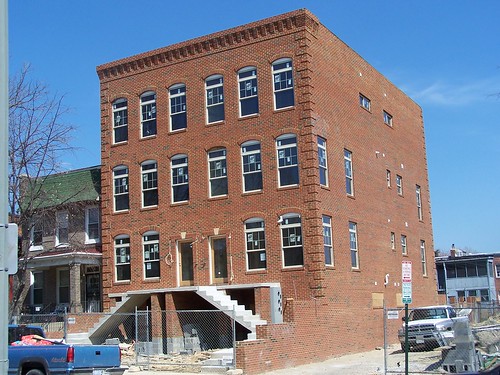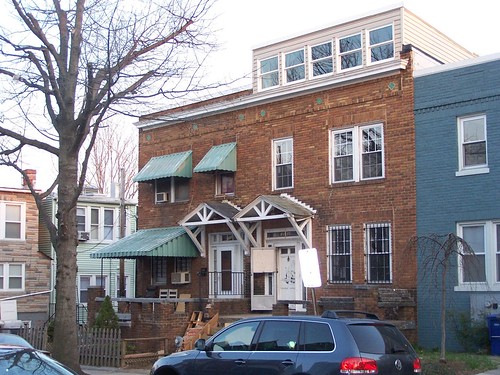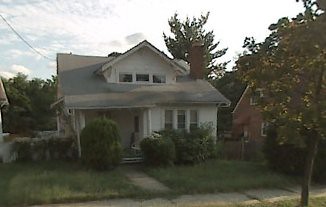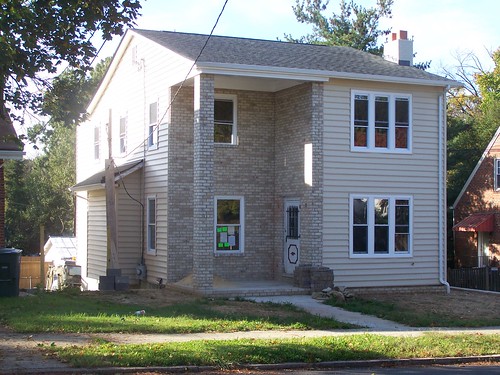Changing matter of right zoning regulations for houses to conform to heights typical within neighborhoods, not the allowable maximum
Generally, I am in favor of the rewrite, because the original code is suburban oriented and DC is a city.
But some of the discussion and reaction "against" the rewrite raises an interesting point about residential building size, which has been a problem for years anyway, regardless of any coming changes to zoning code.
And I think we can solve the problem, with the rewrite or just by a change to the current code.
The problem derives from the fact that much of the city's residential building stock was constructed before 1950, and the house sizes that were typical back then are smaller than what many people prefer today, especially if they watch HGTV or are accustomed to tract home subdivisions in the suburbs.

New rowhouse construction, 1100 block of 5th Street NE. Actually, these are "flats." Each rowhouse has at least two separate units. Note the difference in height between the new buildings and the house to the left. The height of the building to the left is typical of the neighborhood and the period in which it was built, which was probably in the 1920s. The newly constructed buildings are much larger than most houses in the neighborhood, and were built to the allowable maximum height.
Even if "McMansion" sized houses aren't allowed in most neighborhoods, the existing zoning code already allows significantly bigger residential houses to be constructed than are typical of most DC neighborhoods. These newer and much larger buildings tend to be significantly out of context by comparison to the existing building stock, and have the effect of diminishing place value.
In neighborhoods designated as historic, for the most part, the historic preservation regulations act as an "overlay" superior to the basic zoning regulations, and changes that are out of character concerning size generally aren't approved because of the various review processes in place.
In neighborhoods not designated as historic--even though the neighborhoods may in fact be comprised of housing that is considered "historic", just not legally--houses can be built or modified to the maximum allowed by the zoning regulations.

1010 Irving Street NW. What was once a simple two-story rowhouse has been augmented by a discordant third floor addition.
This is the source of the three primary anti-neighborhood/anti-character building construction and alteration practices (although this list is not exclusive):
(1) rear additions that are extremely large
(3) teardowns--demolishing a house that is "small," in order to be able to build a larger house. This tears at the character of neighborhoods in two ways, by eliminating an original house of an architecturally significant style, and by inserting a new, larger house, one that is usually of a significantly different design and style compared to other housing stock in the neighborhood. (Note that teardowns aren't a significant problem in DC, because the cost of housing is so high generally, that it is difficult to do a teardown and make a profit, except in situations where one house is located on two or more lots.)
As part of the zoning rewrite process, protections for neighborhood character should be a mandatory provision within the code, inserted at the outset of the approval of the new code, not something to be added in, neighborhood by neighborhood, after the code is introduced. "Afterwards" is usually too late to stop problems from occuring.
I argue that the point of planning and zoning is to produce and generate routine outcomes that "increase" quality of life, and when the outcomes from our planning and zoning processes don't do this routinely, it is an indicator of a failed process/set of regulations that need to be changed.
When Walmart arrived, the problems of not having adequate zoning regulations in place became obvious, because citizens had limited recourse and for the most part were unable to influence the process in any significant way--all because of the failure to have the right zoning regulations in place before they might be "needed." (It's called "planning" for a reason...)
This is why I recommended the Nashville approach as a framework for the zoning rewrite. The Nashville "Community Character Manual" provides 17 subzones for the land use contexts that most typify DC.
For the most part, those zones and the supporting regulations provide a high level of protection for residents and other stakeholders, without requiring the development of additional regulations. That seems like a much sounder choice.
In another context, Ben Ross, a Montgomery County planning advocate, has made a similar point, that zoning codes tend to have it backward, that "matter of right" regulations tend to privilege the construction of the least quality project, and make it harder to construct the most desirable and highest quality project. In other words, why don't we make it harder to do the wrong thing, and easier to do the right thing? (See this 2011 blog entry, "New years post #6 -- the crazy thing about U.S. zoning is that it's not designed to maximize overall land value.")
Instead of making "matter of right" for the largest possible house, make "matter of right" for the size of a house typical of a neighborhood.
Of course, this size would be coded by neighborhood. On a block with two story rowhouses, two stories would be the "matter of right", on blocks with three story rowhouses, three stories would be the "matter of right". But to build a larger house on the shorter block, or a shorter house on the taller block, special approval procedures would be triggered.
For years I have been surprised that a city so defined by historical excellence in planning (L'Enfant, McMillan Commission) and excellence in architecture, does not require design review for the entire city, regardless of whether or not a neighborhood or building is designated as historic. (Visitors to the city don't just comment on the architecture of the federal buildings, they also comment on the charm and attractiveness of the city's neighborhoods, especially those in the core of the city.)
Before

After

Sure the original house had been neglected for many years, but completely eradicating it in favor of some ersatz design totally disconnected from the neighborhood context shouldn't have been allowed--but it is, because undesignated neighborhoods have no significant design review requirements.
(Although a more robust design review regulation should also address other problems that weren't listed in my top 3.)
Labels: architecture, civic engagement, historic preservation, neighborhood planning, planning, real estate development, urban design/placemaking, urban revitalization, zoning



1 Comments:
Thanks so much for the site, I found a lot of useful information for us.click it...: https://www.dosepharmacy.com
Post a Comment
<< Home